Ant anatomy for Beginners
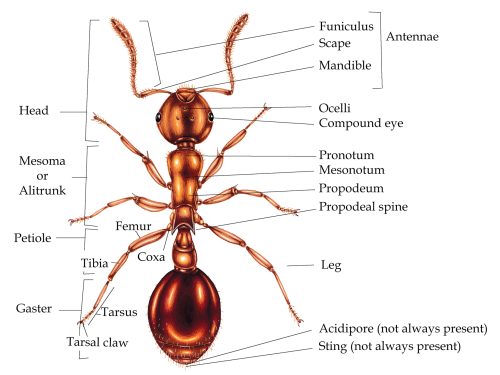
I’ve recently gone on a couple of fabulous courses with Field Studies Council (FSC). Two of these focussed on Ants. They were taught by Gino Brignoli, and the second by Mike Fox, both ant experts. These courses are open to anyone with an interest, and are always an excellent way to learn an enormous amount in a short space of time!
For more on telling the four British subfamilies of ants apart, please check out my future blog. LINK!!!
Introduction to ants
Ants are social insects in the family Formicidea, relations of the other Hymenoptera (bees and wasps), Like them, they live in colonies and have castes of female workers, males (produced normally once a year), and a ruling queen. Worker ants do not have wings, males and queens have four carried in two pairs (although the queens tear theirs off once mated and establishing their nests). Due to their haplodiploid chromosomes, all the females are very closely related, sharing 75% of genetic material.
All ants have similar body shapes, and a sting (or acidopore) at the tip of their abdomen. All have jointed antennae.
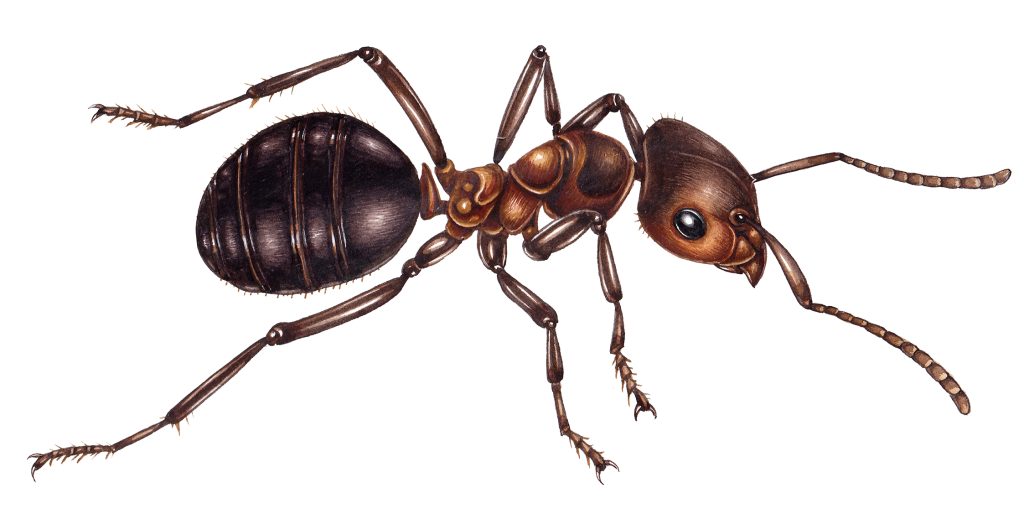
Typical Wood ant
At any one time, there are 10 quadrillion (that’s a 10 with 15 zeros after it) ants alive on planet earth, and of the 30 thousand or so species, only 16 thousand have thus far been identified.
They’re found everywhere on earth except for the poles, and are vital in ecosystems where they help soil aeration, encourage plant diversity and seed spread, and limit numbers of plant pests.
Like humans, many practice farming, famously tending and protecting aphid “cattle” to ensure their supply of sweet honeydew is safe; or growing and eating moulds produced on chewed up leaves they take into their nests.
Ant anatomy: Overview
I thought ants, like other insects (see my blog) had three body parts; namely a head, thorax, and abdomen. What I hadn’t realised is that, with ants, this is a little different.
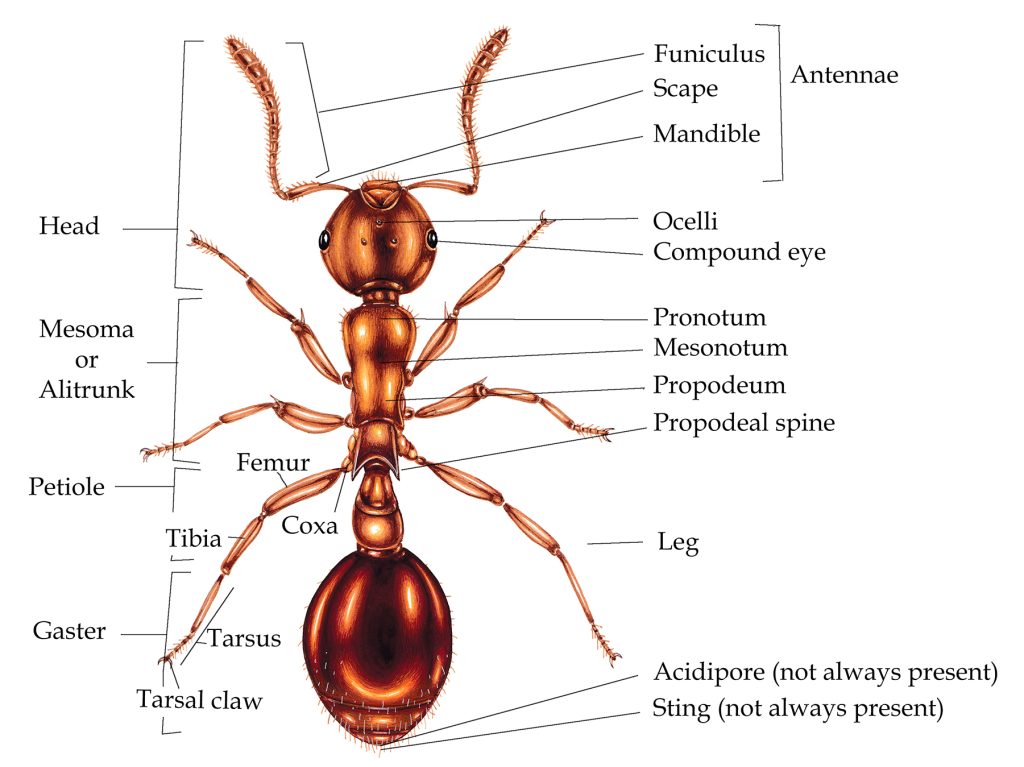
Ant anatomy Shining Guest ant Formicoxenus nitidulus
The Head remains, and there’s more on this and the facial features of ants below. Worth noting is that ants have jointed, or genticulate antennae, light sensitive eye-spots (ocelli), mandibles (mouth parts) and compound eyes.
The Thorax is called the Mesoma, or Alitrunk. it contains the muscles for flight, and serves the same function as the thorax.
The next section is called the Petiole, and is super important in ant identification. It’s the ant’s “waist”.
Then, doing just what the abdomen does, you have the Gaster. The tip of the gaster is where you find the sting, or perhaps an acidopore, which can squirt out acidic irritant.
Ant anatomy: The Head
The ant has large compound eyes, and three light sensitive ocelli which sit on top of its head. Antennae are used to smell, and to groom and interact with other ants. These have a long first segment called a Scape, and the rest of the antennae is called the Funiculus. All ant antennae are jointed, or genticulate (meaning “kneed”). The number of segments this funiculus is composed of is vital when you’re identifying ants to species level. And is extremely tricky to count!
You need to be aware of whether or not the ant has hairs on its head, and if so where they spread to. Again, it’s important for species recognition as one subfamily very rarely have any facial hair at all (the Dolichoderinae).
Other important anatomical details mean you need to take a close look at the ant’s face. I doubt I need to point out that identifying ants to subfamily or species level requires a decent microscope!
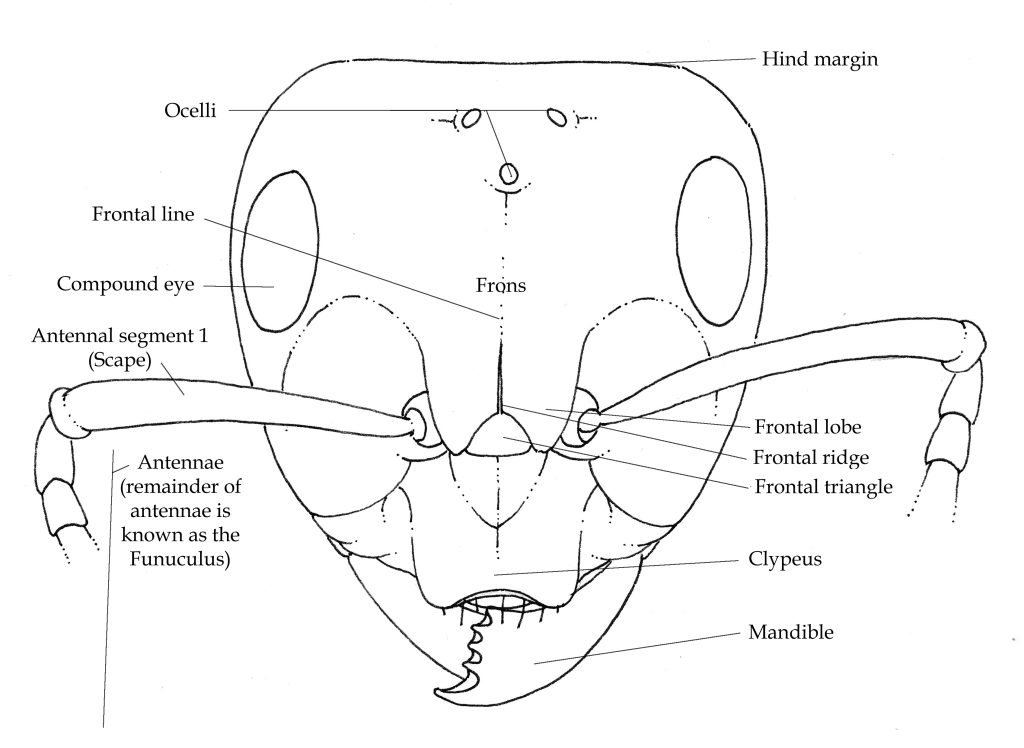
Ant head, face on.
Ants have a top lip. above the mandible, knows as the Clypeus. The shape of this lip matters. Is it curved? Notched?
There’s an area between the antennae which has other diagnostic characteristics. The central line can be seen and is known as the Frontal ridge, either side is the Frontal lobe. The Frontal triangle sits below this.
Ant anatomy: The Mesonoma
The ant thorax has a front part, the Pronotum. The middle is the Mesonotum, and the back part is the Propodeum. This part is analogous to the first segment of the abdomen, but is stuck onto the thoracic region. The Propodeum explains why ants can’t be said to have thorax and abdomens.
Sometimes there’s a prominent spine or pair of spines at the back of this, the Propodeal spines.
Ant Anatomy: The Petiole
The petiole, or the waist, is vital when it comes to identifying ants. Petioles often (but not always) have prominent points or bumps. One subfamily always has two petioles, the Myrmicinae. They’re called the Petiole and post-petiole.
Some species, such as the Shining guest ant Formicoxenus nitidulus, also have a ventral spike, pointing down from their undersides.
The illustration below shows a “typical” side view of the petiole, from a member of the Formicinae subfamily.
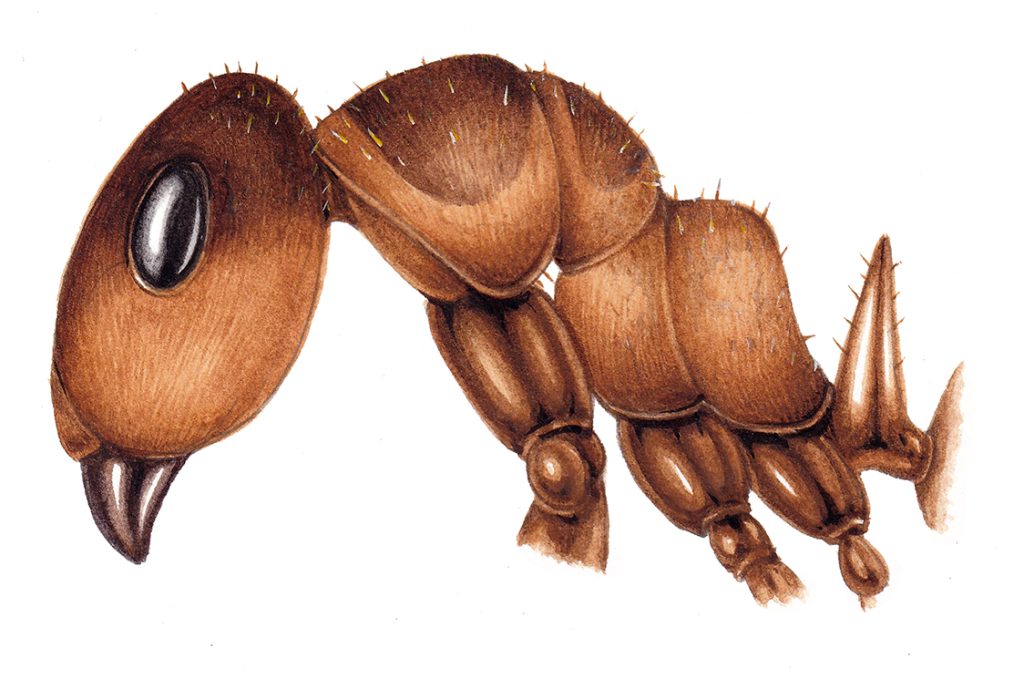
Thorax and hairs detail of Scottish wood ant Formica aquilonia
Ant Anatomy: The Gaster
Generally, the Gaster consists of 5 segments. Some subfamilies of ants have a petiole and a post-petiole, so a two-petioled waist (the Myrmicinae). In this subfamily, there are only 4 gaster segments as the post-petiole has been “taken” from the abdomen.
Some ant species, such as the Saharan ants Cataglyphis bicolor have square petioles. This allows them to hold their gasters up erect, which lets them move much faster than other ants.
Many ants have smooth gasters, but one subfamily always show a distinct constriction between the first and second segment. These are the Dolichoderinae.
At the end of the gaster ants mostly have a sting, or an Acidopore. Males and Queens don’t have stings, as they need this part of their anatomy for reproduction. Interestingly, queen ants do still have poison sacs, although no sting to deliver poison through.
The Acidopore is found in most members of the subfamily Forminaceae, serving a similar purpose to the sting. It delivers formic acid for protection, and this also works as a disinfectant when grooming.
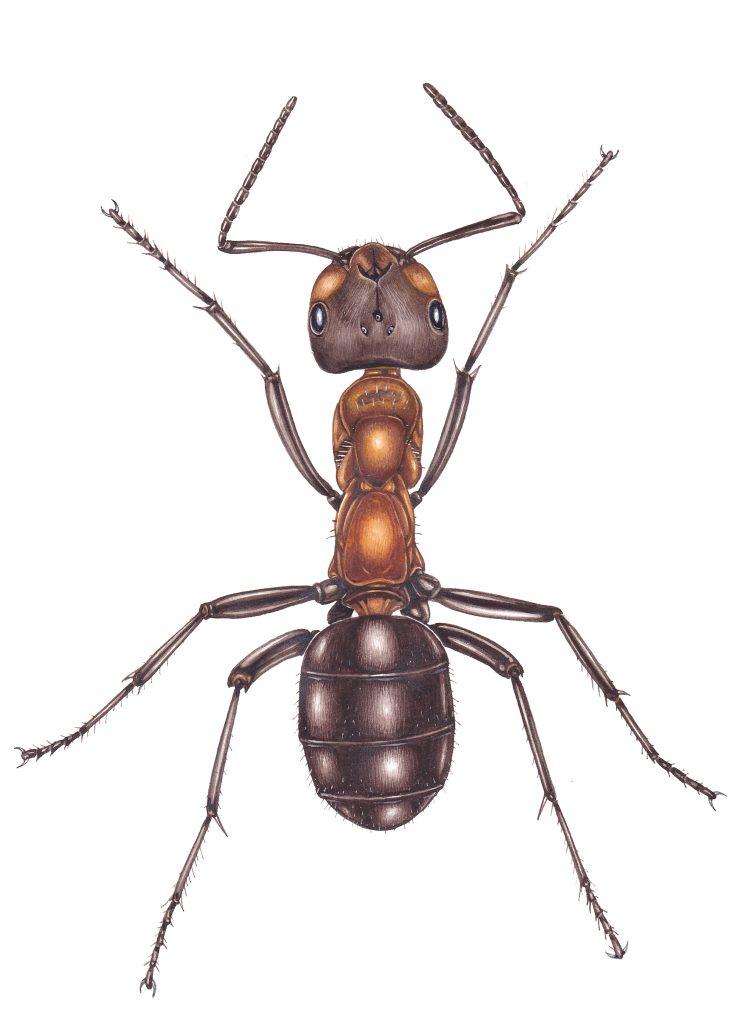
Southern Red wood ant Formica rufa
Seen from above, you may not be able to count all 5 gaster segments as they can curve below the ant. It’s important to examine your ant from the side, as well as from above. (Side views make petiole examination easier, too.)
Conclusion
There’s a lot of new terminology to take on board when you start looking at ants. But if you take it slowly and methodically, it’s not overwhelming. And if, as I do, you want to be able to identify ants to subfamily or species level, then this anatomical crash course is vital!
I’m no ant expert, so please do let me know if there are errors in this blog. And I’d like to thank the FSC and Mike and Gino for opening my eyes to the glories of these amazing insects.


Wow, this post about ant anatomy for beginners is fascinating! As someone who has always been intrigued by the intricate workings of the natural world, learning about the anatomy of ants is truly captivating. Their ability to organize themselves into complex societies and perform incredible tasks is simply mind-boggling. I’m particularly amazed by their segmented bodies, specialized appendages, and the way they communicate using chemical signals. It’s incredible how such tiny creatures can have such intricate anatomical structures. I can’t wait to delve deeper into the world of ants and continue my journey of discovery. Thank you for sharing this educational and engaging post!
Hi Sand, Im so glad you’re intregued. I did one course on ants and was totally hooked, and yes, the intricacy of such tiny creatures in mind blowing. Im really glad you like the blog. X
This was so helpful! I’m doing research for a bug animation I’m making, and I’m including Lasius neoniger, among other insects. This was really clear, concise, and precisely what I was looking for.
It’s gonna be a long while yet, but if you ever see a little animated short about the Karner Blue Butterfly, know that you had a helping hand in it 🙂
Hey Jean, thats really exciting! I would love to see it when it’s done. Animation is so darned clever, I love the idea that in some tiny way I may have been useful!
Very useful article. Thankyou!
My pleasure
Ants have been part of many of my life stories.
They are wonderful servants. Often they are unnoticed.
They clear up my dropped sweet bits.
They get on with their own world.
I want to observe their social life.
Hi John
Totally agree. And so many people overlook them!
I really enjoyed reading your article! Thank you…